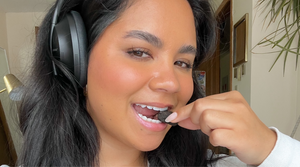If you have ever had a UTI or strep throat you’ve probably been prescribed an antibiotic before. Your doctor might have recommended you take probiotics during the treatment, or eaten some extra yogurt. If you were curious about why this was recommended to you and how probiotics and antibiotics affect each other and your body, keep reading!
What are probiotics?
Probiotics are the live bacteria and yeast that are beneficial to your body. These living microorganisms help restore the natural balance of gut bacteria, specifically to help keep the digestive system healthy (1). When probiotics keep your gut healthy, the resulting benefits can range from regulated bowel movements, improved mental health, and a boosted immune system (2).
What are antibiotics?
Antibiotics are a common medication that fights a bacterial infection when the immune system is not able to do so. In common situations, like a small wound, the immune system is able to fight off bacteria, but in more severe cases, antibiotics can resolve health issues and even save lives.
While antibiotics can be vital in some situations, they are not a medication to be taken lightly because of the side effects and damage to the body that comes with abusing the medication. Antibiotic resistance happens when the bad bacteria in your body evolve to be able to withstand the medication that is supposed to destroy them (3). This means that these bad bacteria survive and continue to grow. Antibiotic resistance poses a risk each time antibiotics are used, but is specifically dangerous when antibiotics are overused or misused (4).
Another side effect of taking antibiotics is that in addition to killing the infection causing bacteria, studies have shown antibiotics can destroy good bacteria that your body needs (5). This risk increases with higher doses and longer periods of time an antibiotic is taken (5).
What is a biome and how does this affect it?
Your gut microbiome is a complex ecosystem of bacteria and other microorganisms that survive in your digestive tract. Although there are many elements of the biome that are unknown and still being studied, one of the most proven and important parts of a healthy biome is a high diversity of bacteria (5). Since taking antibiotics does the opposite of this by killing off bacteria, it can be very detrimental to your biome.
An apparent example of these complications to your biome is antibiotic-associated diarrhea, which can affect up to 20% of people taking antibiotics (6). The idea here is that the antibiotics disrupt the way the biome and its good bacteria normally function, causing complications in your gut and digestive system.
What should you do about it?
Taking probiotics during and after using antibiotics is one of the most common ways to potentially help your gut bacteria stay diverse (5). There is evidence that taking probiotics can prevent antibiotic-associated diarrhea and decrease the risk of opportunistic pathogens invading the biome (5).
Because each person has a different microbiome, there is no way to know what is the best option or probiotic for everyone, but strains like bacteria Lactobacillus rhamnosus GG, or LGG, and Saccharomyces boulardii have been proven to have beneficial effects (6). It is important to space out the time between when you take your antibiotic and probiotic. If taken too close together the antibiotic could potentially kill the good bacteria you are giving to your body. Most professionals recommend waiting two hours after taking an antibiotic to take a probiotic in order to give the probiotic a higher chance of surviving (7).
In addition to supplemental probiotics, there are ways to increase your probiotic intake through the foods you eat (8). Diversifying your diet can help diversify the nutrients and good bacteria you intake, which is important for a healthy biome. Also, fermented foods like yogurt, sauerkraut and kefir all contain very beneficial bacteria. Avoiding foods with high sugar is another important tip because sugar has been shown to increase inflammation and feed the growth of bad bacteria in the gut (9).
Importance of a healthy biome
It is crucial to be aware of how what you put in your body affects your biome because of how much your body is affected by it. The gut microbiome plays an important role all throughout a person's life from digesting breast milk and fiber, to supporting a healthy immune system and overall brain health (8). In addition, an imbalanced biome can lead to weight gain and an unhealthy digestive tract (8).
If you want a healthy biome, the most important points to remember are avoid taking antibiotics when you can, use a probiotic while on antibiotics or daily, and try to keep your diet diverse and low on sugar!
Interested to learn more about the microbiome? Check out this article here.
Sources:
2. https://www.healthline.com/nutrition/8-health-benefits-of-probiotics#section2
3. https://www.cdc.gov/drugresistance/about.html
4. https://www.ncbi.nlm.nih.gov/pmc/articles/PMC4378521/
5. https://healthpath.com/gut-health/how-long-restore-gut-health-after-antibiotics/#chapter5
6. https://health.usnews.com/wellness/articles/getting-your-probiotic-fix-when-taking-antibiotics
8. https://www.healthline.com/nutrition/gut-microbiome-and-health#section8
9. https://drmicrobiome.com/health/how-sugar-affects-the-microbiome/
Photo by Ola Mishchenko on Unsplash






